20 Pollinator Plants for Eco-Friendly Front Yards
Transform your yard into a vibrant ecosystem with plants that attract essential pollinators. Choose from 20 fantastic options, including the colorful Butterfly Bush, to create a haven for bees, butterflies, and hummingbirds.
These plants not only enhance your garden’s beauty but also support the crucial role of pollinators in our ecosystem. Explore these options to cultivate a thriving environment right in your front yard!
Butterfly Bush (Buddleja Davidii)
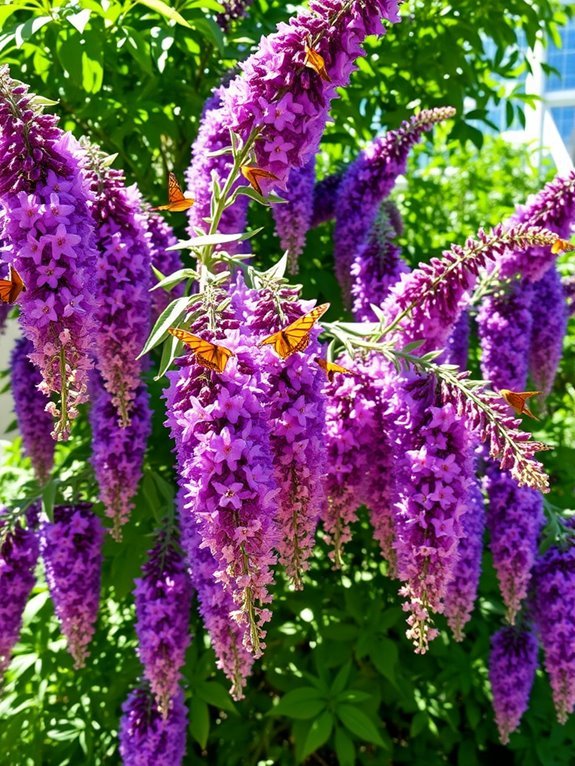
When it comes to attracting butterflies to your front yard, the Butterfly Bush (Buddleja Davidii) is like a VIP lounge for these beautiful insects.
With its vibrant flowers in shades of purple, pink, and white, it’s a showstopper! Plant a few of these beauties, and you’ll soon find butterflies fluttering around, sipping nectar like they’re at an all-you-can-eat buffet.
Plus, they’re easy to grow and love sunny spots. Just remember, they can get a bit wild, so don’t forget to trim them back!
Your front yard will turn into a butterfly paradise, and you’ll be the envy of the neighborhood!
Coneflower (Echinacea Purpurea)
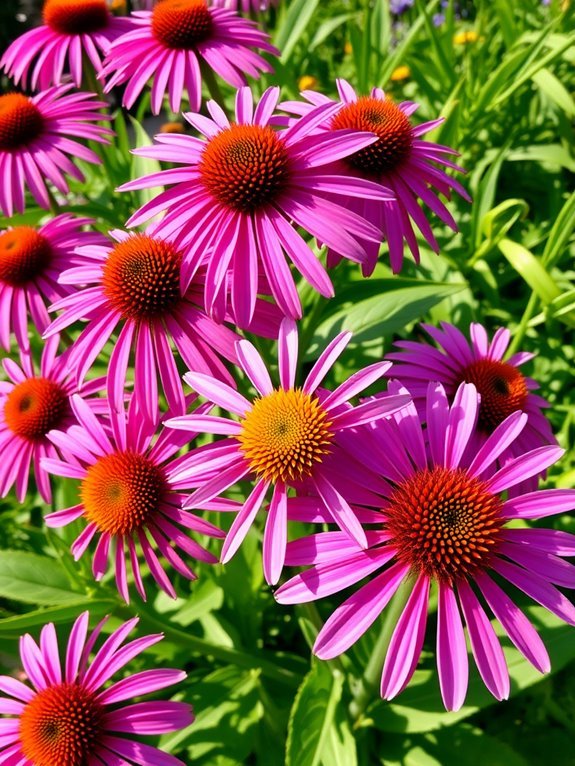
If you thought the Butterfly Bush was the ultimate butterfly hangout, wait until you meet the Coneflower (Echinacea Purpurea)!
These vibrant beauties aren’t just eye candy; they’re a magnet for pollinators. You’ll love how easy they’re to grow and how they attract a buzzing crowd.
Here’s why you’ll want them in your yard:
- Bright, daisy-like blooms
- Attracts butterflies, bees, and birds
- Drought-resistant and low-maintenance
- Blooms from summer into fall
- Great for cut flower arrangements
Black-Eyed Susan (Rudbeckia Hirta)
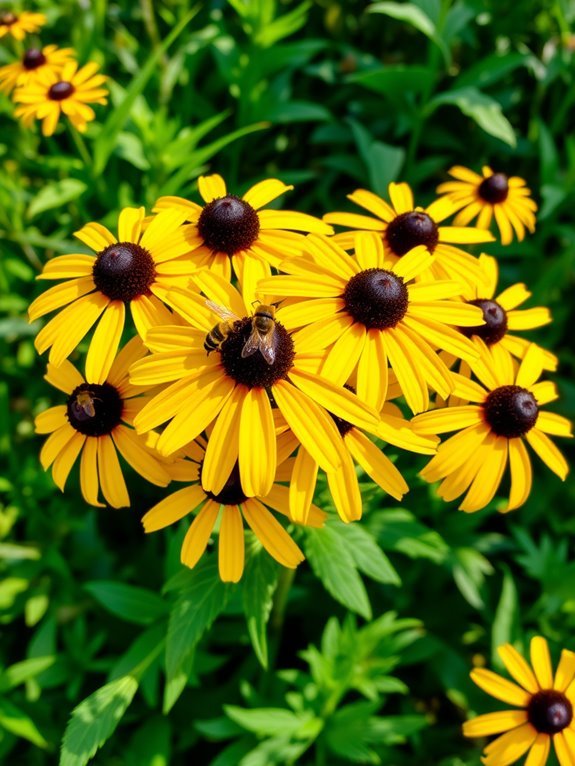
Black-Eyed Susan (Rudbeckia Hirta) is like the cheerful friend you never knew you needed in your garden! With their bright yellow petals and dark centers, these beauties instantly lift your spirits.
They’re hardy and low-maintenance, so you won’t have to babysit them. Plus, they attract butterflies and bees, making your yard a buzzing hotspot!
Just imagine sipping your morning coffee, watching pollinators dance around. Plant them in clusters for a dazzling display, and they’ll bloom from summer into fall, bringing joy for months.
Milkweed (Asclepias Spp.)
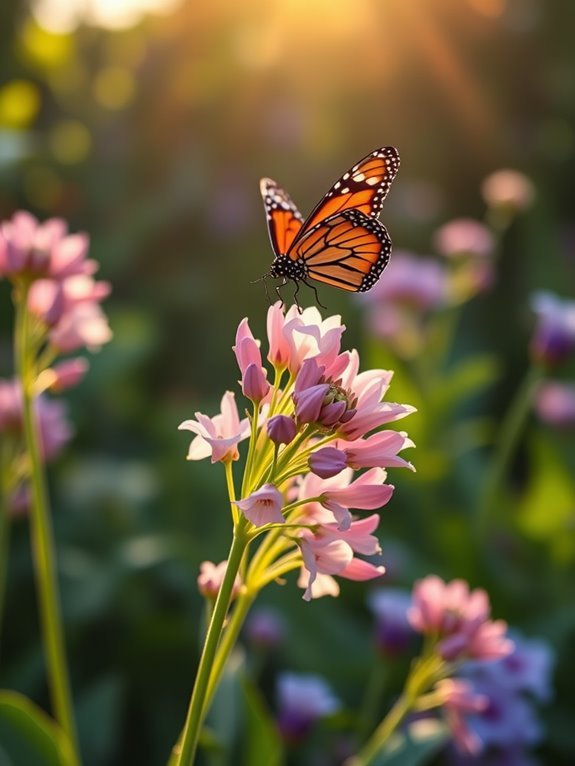
Milkweed (Asclepias Spp.) is like the VIP lounge for butterflies, especially the beloved monarchs!
When you plant milkweed, you’re not just adding beauty; you’re creating a haven for these amazing pollinators.
Here’s what you’ll love about it:
- Attracts monarchs like a magnet
- Provides essential habitats for caterpillars
- Comes in various colors and heights
- Thrives in sunny spots with minimal fuss
- Supports local ecosystems and biodiversity
Bee Balm (Monarda Didyma)
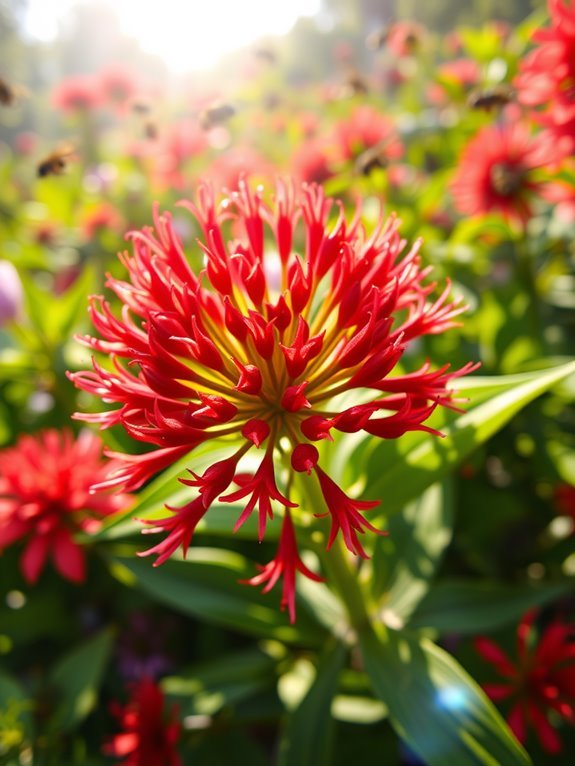
After rolling out the welcome mat for monarchs with milkweed, it’s time to invite another fabulous guest to your eco-friendly garden: Bee Balm (Monarda Didyma).
This vibrant perennial isn’t just a feast for the eyes; it’s a buffet for bees, butterflies, and hummingbirds! With its striking red, pink, or purple blooms, it’ll add a splash of color while supporting your local pollinators.
Plus, Bee Balm’s aromatic leaves can even be used in tea—talk about a double-duty plant!
Lavender (Lavandula Spp.)
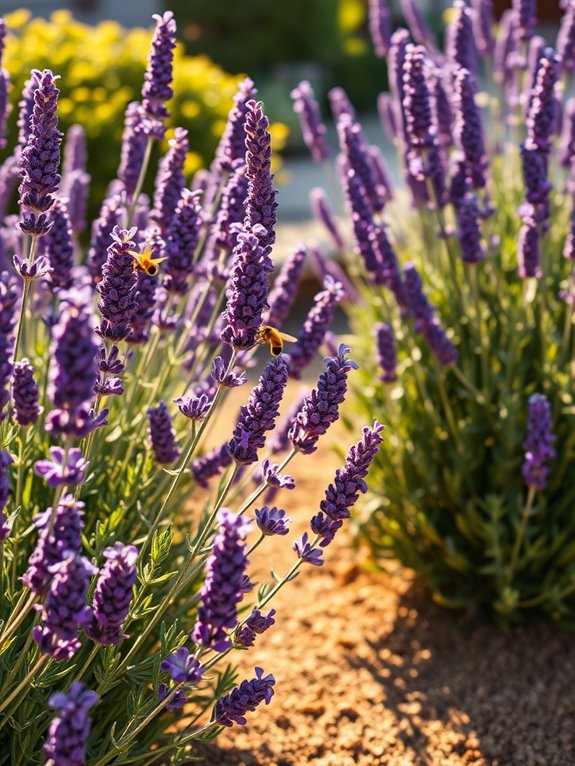
If you’re looking to add a touch of elegance to your eco-friendly front yard, Lavender (Lavandula Spp.) is the perfect plant to contemplate!
Its stunning purple blooms don’t just look great; they also attract a variety of pollinators. Plus, who doesn’t love that delightful scent?
Here are some great reasons to choose Lavender:
- Attracts bees and butterflies
- Drought-tolerant once established
- Low-maintenance and hardy
- Versatile in landscaping designs
- Perfect for culinary uses
Aster (Aster Spp.)
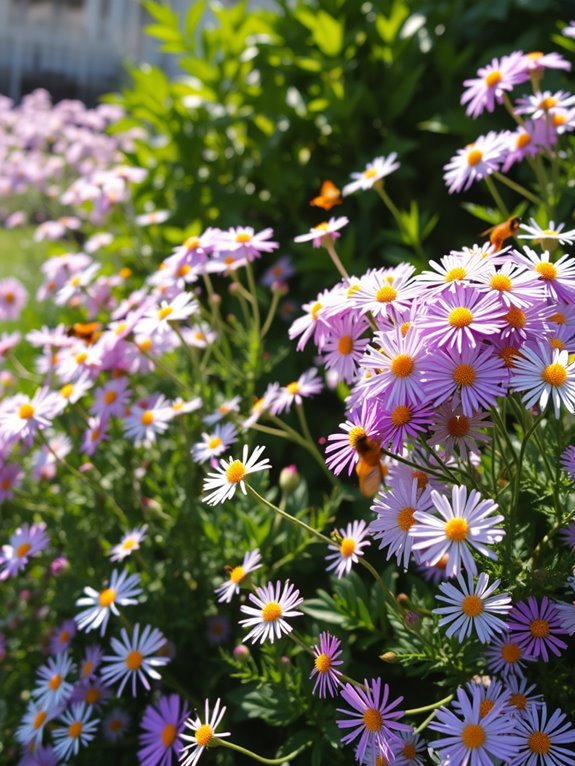
Asters (Aster Spp.) are like the cheerful party guests of your eco-friendly front yard, bringing a burst of color and a swarm of pollinators along with them!
These delightful flowers bloom in various shades, from purples to whites, and attract butterflies and bees, making your garden a buzzing hotspot.
They thrive in sunny spots and are low-maintenance, so you can enjoy their beauty without much fuss.
Plus, their late-season blooms are a lifeline for pollinators preparing for winter.
Salvia (Salvia Spp.)
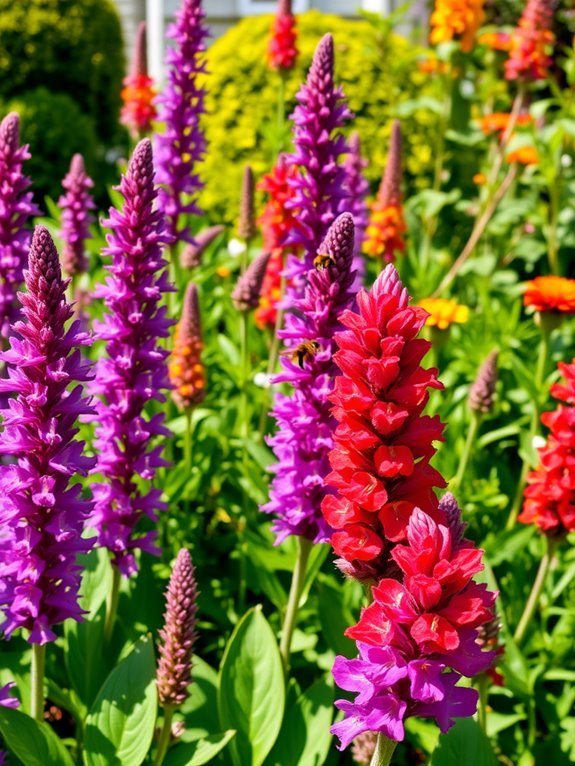
Salvia (Salvia Spp.) is like the secret weapon in your eco-friendly front yard, ready to dazzle both you and the pollinators!
These vibrant plants not only add a splash of color but also attract hummingbirds and bees, making your yard a buzzing hotspot.
Here are some fun facts about Salvia:
- They come in various colors, from deep blue to bright red.
- Many species are drought-tolerant, saving you water!
- They bloom from spring to fall, providing long-lasting beauty.
- Salvia’s aromatic leaves can deter pests.
- They’re easy to grow and maintain, even for beginners!
Goldenrod (Solidago Spp.)
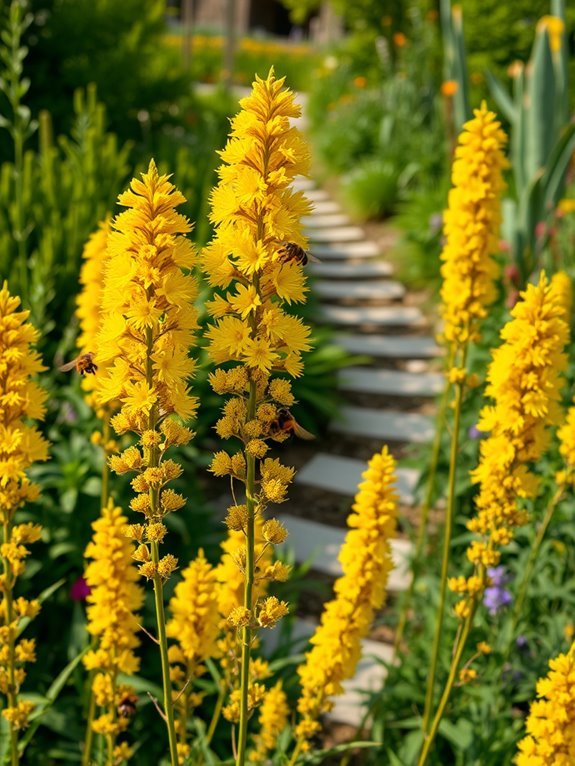
Goldenrod (Solidago Spp.) is like a sunny celebration in your eco-friendly front yard, bursting with golden blooms that beckon pollinators from near and far!
These cheerful plants thrive in various conditions, making them a breeze to grow. They’re not just pretty; they also provide essential nectar for bees, butterflies, and other pollinators.
Plus, their vibrant color adds a splash of joy to your garden. Just imagine strolling through your yard, surrounded by flitting butterflies and buzzing bees, all thanks to your goldenrod!
Penstemon (Penstemon Spp.)
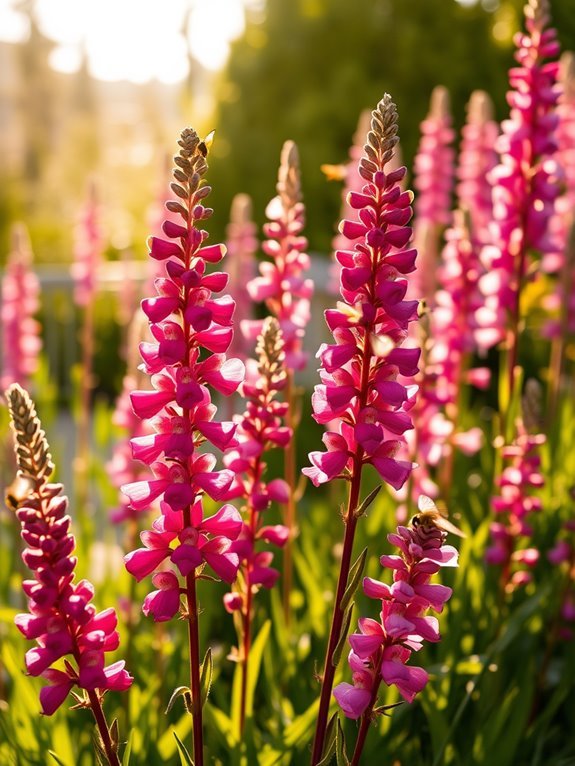
If you’re looking to add a splash of color and attract some buzzing friends to your front yard, Penstemon (Penstemon Spp.) is the perfect choice!
These vibrant flowers come in various shades, making your garden pop. Plus, they’re a magnet for pollinators like bees and hummingbirds.
Here’s why you’ll love Penstemon:
- Hardy and drought-tolerant
- Long blooming season
- Attractive to various pollinators
- Easy to maintain
- Comes in many colors
Plant them where they get plenty of sunlight, and you’ll be rewarded with a lively, colorful haven that supports our buzzing buddies!
Zinnia (Zinnia Elegans)

After adding the lovely Penstemon to your garden, why not consider Zinnia (Zinnia Elegans) for even more color and charm?
These vibrant flowers bloom in a rainbow of hues, attracting bees and butterflies like kids to a candy store! Zinnias thrive in full sun and are super easy to grow, making them perfect for your eco-friendly front yard.
Plus, they’re drought-tolerant, so you won’t have to babysit them with constant watering. With their cheerful blooms, you’ll not only brighten your space but also give pollinators a delightful feast.
Who knew gardening could be this fun? Grab some seeds today!
Yarrow (Achillea Millefolium)

Yarrow (Achillea Millefolium) brings a touch of wild beauty to any eco-friendly front yard, and you won’t want to miss out on this hardy perennial!
Not only is it low-maintenance, but it also attracts a flurry of beneficial pollinators. Here’s why you’ll love it:
- Drought-tolerant, saving you on watering
- Blooms in vibrant colors, adding flair
- Strong stems that hold up in storms
- Medicinal properties, a bonus for herbal enthusiasts
- Easy to propagate, so share with friends!
With yarrow, you’ll enjoy a lively garden that’s as functional as it’s beautiful.
Plus, bees will thank you!
Phlox (Phlox Paniculata)

Phlox (Phlox paniculata) is like a cheerful party guest that brightens up your garden with vibrant blooms and sweet fragrances!
These perennial flowers come in a rainbow of colors, attracting butterflies and bees like a magnet. Just imagine your front yard buzzing with life, all thanks to these lovely plants!
They’re easy to grow, thriving in sunny spots, and they love well-drained soil. Plus, they’ll keep blooming all summer long, bringing joy to your outdoor space.
Marigold (Tagetes Spp.)

If you’re looking to add a splash of color and a whole lot of charm to your front yard, marigolds (Tagetes spp.) are just the ticket!
These bright beauties attract pollinators like bees and butterflies, making your garden a buzzing paradise. Plus, they’re super easy to grow. You’ll love their cheerful hues and delightful fragrance.
Here’s why you should consider marigolds:
- Bright, vibrant colors
- Natural pest repellents
- Low maintenance
- Perfect for borders or containers
- Bloom all summer long
Plant them, sit back, and watch your front yard transform into a lively haven for both you and your buzzing friends!
Verbena (Verbena Bonariensis)
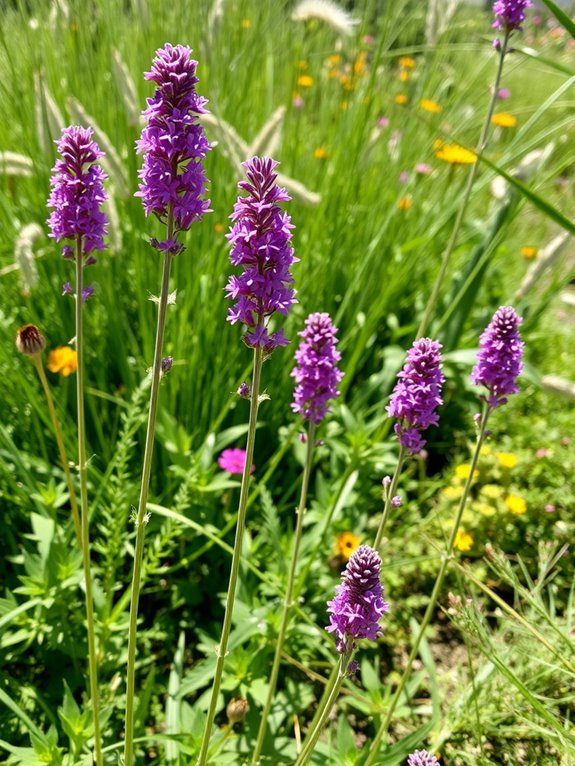
When you want to create a stunning front yard that’s also a pollinator’s paradise, seek no additional options than verbena (Verbena bonariensis).
This tall, slender beauty bursts with vibrant purple flowers, attracting butterflies and bees like a magnet!
It’s a tough plant that thrives in various conditions, so you won’t have to babysit it. Just plant it, sit back, and watch the magic happen!
Plus, verbena’s airy structure adds a delightful touch to your garden, almost like nature’s confetti.
Catmint (Nepeta Spp.)
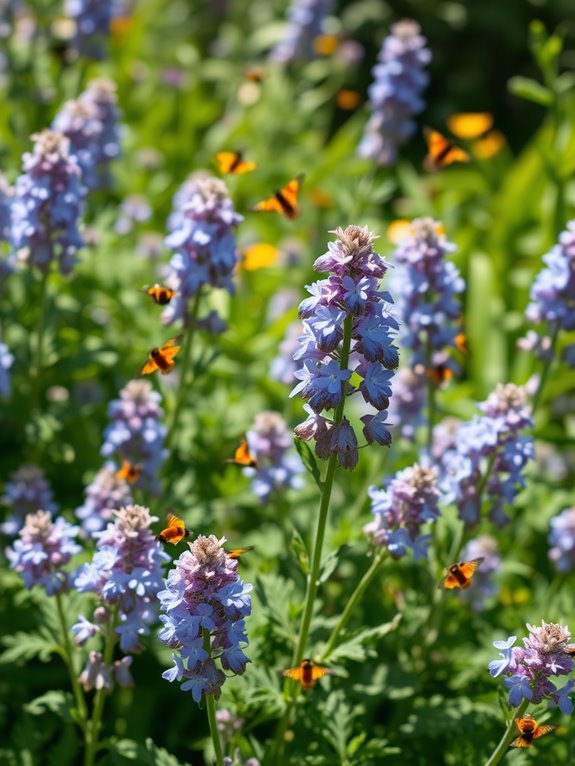
Catmint (Nepeta spp.) is like the party planner of your front yard, ready to bring in all the buzzing guests!
This delightful plant attracts bees, butterflies, and other pollinators with its vibrant blooms and aromatic foliage. Plus, it’s super easy to care for!
Here’s why you’ll love it:
- Thrives in full sun
- Drought-tolerant once established
- Blooms from spring to fall
- Makes a great ground cover
- Offers a lovely minty scent
Heliopsis (Heliopsis Helianthoides)
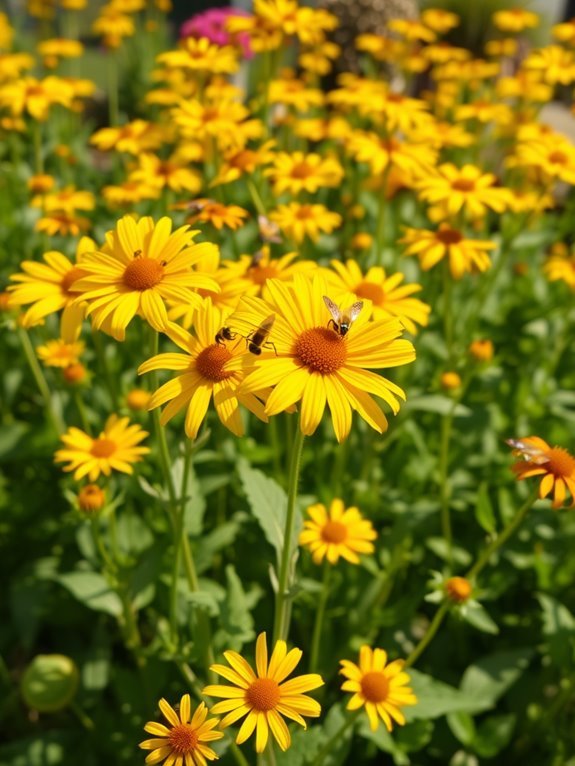
Imagine a sunny day in your front yard, with golden blooms swaying gently in the breeze—this is what Heliopsis (Heliopsis helianthoides) brings to the table!
Known as the false sunflower, this cheerful perennial loves basking in the sun. Its vibrant yellow flowers attract a variety of pollinators, including butterflies and bees, making your yard a buzzing hotspot.
Plus, they’re low-maintenance and drought-tolerant, so you can enjoy their beauty without constant fuss. Just think of it as a golden invite for our buzzing pals!
Add Heliopsis to your garden, and watch nature come alive in a spectacular way!
Fennel (Foeniculum Vulgare)
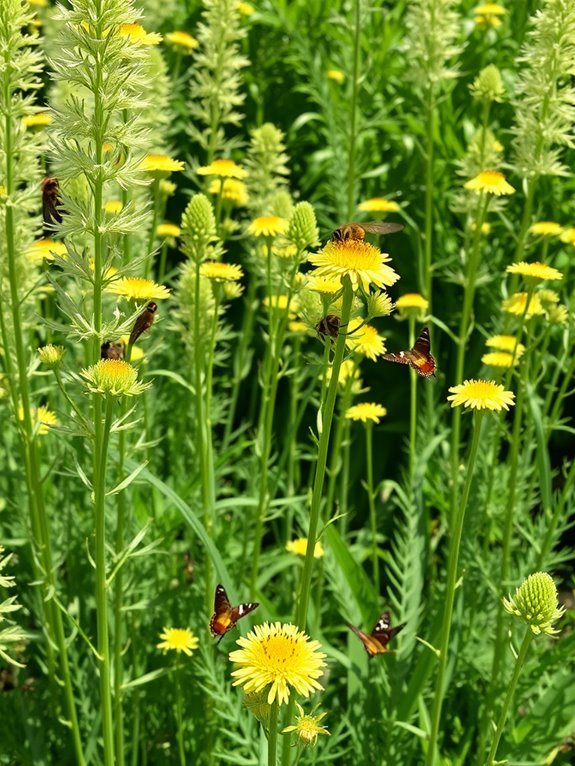
If you’re looking to spice up your front yard while attracting a swarm of friendly pollinators, fennel (Foeniculum vulgare) is your go-to plant!
This aromatic herb not only adds flavor to your dishes but also draws in beneficial insects like butterflies and bees.
Here’s why you’ll love it:
- Tall, feathery foliage that adds elegance
- Yellow flowers that bloom in summer, providing a feast for pollinators
- Easy to grow, even for beginners
- Tasty, edible seeds for culinary adventures
- A delightful scent that keeps pests at bay
Plant fennel, and watch your front yard buzz with life and flavor!
Cosmos (Cosmos Bipinnatus)
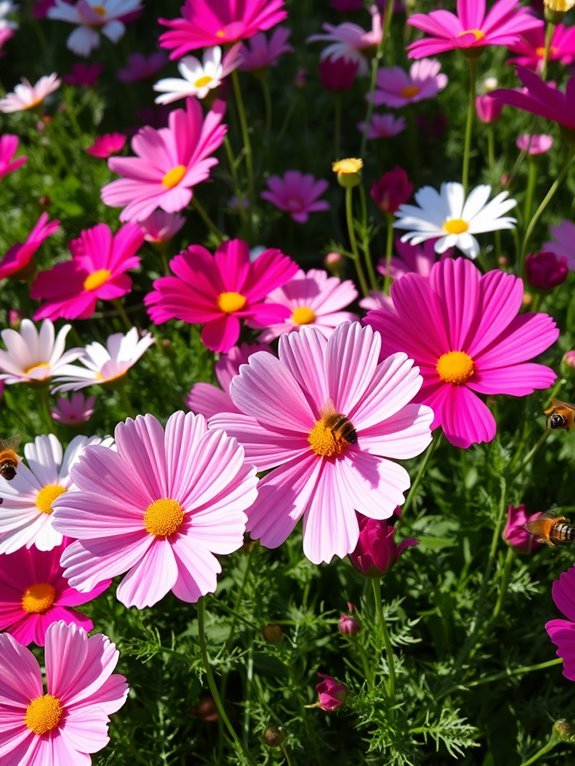
After you’ve enjoyed the aromatic charm of fennel, it’s time to add another showstopper to your eco-friendly front yard: cosmos (Cosmos bipinnatus).
These vibrant beauties bloom in a rainbow of colors, attracting bees and butterflies like magnets. With their delicate, feathery foliage and cheerful blossoms, cosmos aren’t just pretty faces; they thrive in poor soil and love the sun!
You won’t have to fuss over them much—just a little water and they’re happy. Plus, they can grow tall or short, so you can mix and match for a delightful display.
Your garden will thank you, and so will the pollinators!
Snapdragons (Antirrhinum Majus)

Snapdragons (Antirrhinum majus) are like the quirky performers of the garden, bringing a splash of color and personality to your eco-friendly front yard.
These charming flowers attract all sorts of pollinators, making your space lively and vibrant. Plus, they’re easy to grow!
Here are some reasons to love snapdragons:
- They bloom in multiple colors, creating a stunning visual feast.
- They thrive in cooler temperatures, extending your garden’s season.
- Their unique shape invites curious hummingbirds and bees.
- They’re great for cutting, brightening up your home.
- They add vertical interest, making your yard feel dynamic.
Get ready to enjoy their whimsical charm!
Frequently Asked Questions
How Do I Choose the Right Pollinator Plants for My Climate?
To choose the right pollinator plants for your climate, research native species that thrive in your area. Consider factors like soil type, sunlight, and moisture levels to guarantee your plants flourish and attract beneficial pollinators.
Can I Grow These Plants in Containers or Raised Beds?
You can grow pollinator plants in containers or raised beds easily. In fact, over 70% of flowering plants depend on pollinators, so providing these habitats helps support biodiversity in your garden and your community.
What Maintenance Do Pollinator Plants Require Throughout the Year?
Pollinator plants need regular maintenance, including watering, pruning, and deadheading. You’ll want to monitor for pests and diseases too. Seasonal mulching helps retain moisture and suppress weeds, ensuring your plants thrive throughout the year.
How Can I Attract More Pollinators to My Yard?
To attract more pollinators, plant diverse flowers that bloom at different times. Avoid pesticides, provide water sources, and create shelter with native plants. You’ll notice an increase in butterflies, bees, and other helpful insects.
Are These Plants Safe for Pets and Children?
You might wonder if those vibrant plants are safe for your pets and kids. Many pollinator-friendly options are non-toxic, but it’s essential to double-check specific varieties to guarantee a safe, welcoming environment for everyone.
Conclusion
Transform your front yard into a lively haven for pollinators. Imagine bees buzzing and butterflies dancing as you plant these 20 vibrant plants.
Creating a beautiful space is just part of the benefit; you’re also supporting our essential friends of nature. With a little effort and color, your yard can become a delightful retreat for both you and the pollinators.
Let’s get planting!





